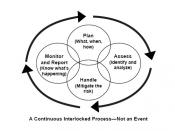introductionEvents outside the control of the project management - and the team as a whole - can occur that jeopardizes the success of the project. Every project is exposed to some level of risk. The ability of the project manager to identify risk and develop plans to mitigate those risks will determine the severity of the impact risk will cause. Projects that fail do so because a risk was not identified or adequately mitigated. The Ariane 5 launcher project encountered a severe setback when the launcher exploded shortly after takeoff on its maiden flight. The cause of the failure was a problem that, if identified and mitigated, could have been negated. This paper will briefly discuss the Ariane 5 project failure and how risk management could help in preventing the failure from occurring.
Risk identificationRisk management is simply that - the management of risk through identification and mitigation. Every project plan should incorporate some form of a risk management plan. A risk management plan details the steps to identify risk, the severity the risk poses to the project if it were to occur, and the steps to be taken to mitigate the risk.
Identifying risk is critical in the risk management process. Risks can be determined by several methods: analysis of the project plan for failure, analysis of similar projects, review of historical data and the review of the lessons learned by previous project. Not all risks will be identified. Unknown risks lurk in every project. Project managers must learn to identify all risks, whether known or unknown, and the best way to mitigate those risks.
Risk severity is categorized in two categories - probability the risk will occur if not mitigated and the level of impact to the project if it occurs. A risk that has a high probability of occurring but little impact may be allowed to happen if the problem is easily rectified after it occurs. However, risks that have likelihood of occurring and pose a significant threat to project outcome will require mitigation by project management. The project manager may take preventive steps to avoid the occurrence of the risk or install safeguards within the project to minimize the impact when it occurs.
Ariane 5 failure descriptionAccording to the Inquiry Board Report, Ariane 5 Flight 501 experienced a catastrophic failure approximately 40 seconds after takeoff (Lions, 1996). An inquiry board was established immediately following the incident with the objectives to:â¢determine the causes of the launch failure,â¢investigate whether the qualification and acceptance tests were appropriate in relation to the problem encountered, andâ¢recommend correction action to prevent the incident from reoccurring.
What the inquiry board uncovered is purportedly one of the most expensive computer bugs in history.
The Ariane 5 project brought forward several components of its predecessor, the Ariane 4, including software packages that controlled critical aircraft attitude and navigation processes. The inquiry board determined that an Operand Error caused the launcher to lose control, which subsequently led to the self-destruct safety feature being activated. The Operand Error was caused by horizontal bias values being higher than expected due to a conversion error from 64-bit to 16-bit floating point values without features in place to protect against out-of-bounds values, a legacy requirement from the Ariane 4.
Obviously, the risk management failed in the Airane 5 project. Risk was assumed when the decision was made to reuse software coding from a preceding project. While this may make financial sense at the time, the project failed due to incompatibility of the legacy software with the current application - ultimately costing the project significantly. Project management failed to adequately test the software. Had the software bet properly regression tested, the unknown risk could have been properly identified and mitigated.
ConclusionRisk is everywhere and poses a threat to every project. If left unresolved, risk can bring any well-planned planned to failure. The identification and mitigation of risk is the cornerstone of an effective risk mitigation plan. Ariane 5 failed to identify the risk of importing software from legacy projects. By failing to identify the risk, Ariane 5 project was unable to develop a mitigation strategy which resulted in the loss of a multi-million dollar launcher and significant schedule setbacks.
ReferencesLions, J. (1996, July 19). Ariane 5 Flight 501 failure report by the inquiry board. Retrieved September 28, 2009, from http://esamultimedia.esa.int/docs/esa-x-1819eng.pdf.



